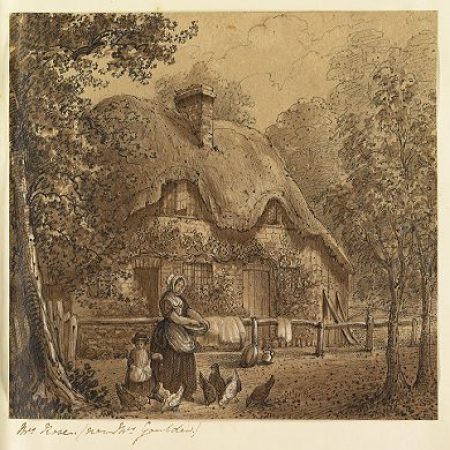The album was secured for the Hampshire Record Office with support from HAT. It contains drawings of East and West Wellow, c1846.
The album of drawings of buildings and scenes in the west Hampshire village of Wellow is by an unknown artist, and produced in c1846. The album provides a close and meticulous study of the village of Wellow in the mid-nineteenth century, in 109 pencil, chalk and wash drawings, presenting an unparalleled record of life in a Hampshire village at this time. It shows the local people, farms and cottages, and landscapes of Wellow.
The album is remarkable in that it focuses on the ordinary and the day-to-day. Although the artist does include views of Embley Park, the childhood home of Florence Nightingale, what makes the drawings so unusual is that most of them depict the activity of farm labourers, women and children: suddenly people who have just been a few lines in parish registers or census returns can be seen going about their day-to-day lives. Moving around Wellow, the artist depicts a woman feeding chickens, children playing outside their school, pigs in a farmyard, labourers in a hayfield, the cherry and apple trees and beehives of the villagers, a camp-fire with a group of travelers, and the arrival of a coach and horses.
The drawings are the work of a good amateur artist, one of whose strengths was to be able to produce carefully-drawn views of the many houses in the village, showing clearly the range of building materials in use in the area – brick, tile, timber and thatch – and also farm vehicles, livestock and implements, such as carts, wagons, barrels, brooms and bee skeps. The album therefore sheds valuable light on mid nineteenth century farm buildings and agriculture.
The identity of the artist is not known for certain. This study of the village and its people starts and ends with the church and vicarage, and includes intimate scenes of the vicarage such as a view of the garden on a misty morning; this makes it seem likely that it is the work of a member of the family of the Revd William Henry Empson, who became vicar of Wellow in 1844, about two years before the album was started. The most likely possibility is perhaps his mother-in-law, Mrs Mary Rawson: one of the drawings has the caption ‘self and daughter’ and shows two women, one older, one younger, who could possibly be Mrs Empson and Mrs Rawson.
Several Community Projects resulted from the purchase of the Wellow Album
An exhibition was produced by Wellow History Society, and included colour reproductions of many of the drawings in the albums, together with modern photographs of the same views and explanatory text showing how the lanes, cottages and other buildings have changed over the last 170 years – or, in some cases, how they have survived almost unchanged, at least externally. The captions gave some insights into the people who have lived there over the years, and maps have been provided to show exactly where all the scenes are located. In addition there was also an art project led by local artist Heather Butler, at Wellow Primary School, in which children from the school drew pictures of the villages of East and West Wellow as they look today, learning how to use the same pencil-and-wash technique as the original artist, and also produced still life pictures of household objects similar to some of those shown in the album. The artwork was scanned at Hampshire Record Office and used in a series of pop-up banners, a booklet about the project and a CD, digitised and presented in the same format as the original album. To support the exhibition a 52-page publication, fully illustrated in colour, and featuring reproductions of 40 of the drawings, with equivalent modern views of most of the locations, and historical details about all the buildings shown in the album was produced. In addition a free talk was also given about research into the album and some of the clues to the identity of the artist. Hampshire Archives Trust provided a total of £3000 towards the project.
The Wellow Album of drawings from the 1840s (HRO ref 124A11/1)
Professor Sleigh in the foyer of HRO in 2013 with part of the exhibition devised by Wellow History Society showing ‘then and now’ images of Wellow, with reproductions of drawings from the album alongside modern photographs of the same locations

